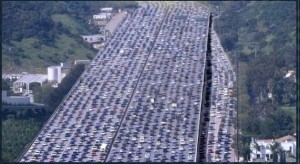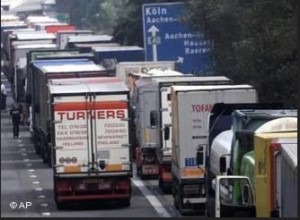Background
Emissions from the transport sector represent a significant challenge for meeting European Union targets for reducing Greenhouse gases (GHGs), as discussed in the recent European Environment Agency (EEA) report on Evaluating 15 years of transport and environmental policy integration. Transport emissions are second only to the energy sector in the EU, and represent about 25% of total EU GHG emissions. While the other sectors have lowered their GHG emissions, the transport emissions have continued to increase. In Ireland transport emissions are second to agriculture. Even if additional mitigation measures are taken in Ireland, by 2030 agriculture will contribute about 44% of the country’s GHG emissions, and the transport sector will contribute about 36%, totaling 80% of GHG emissions between the two sectors.
Besides challenges for reducing GHG emissions, the transport sector creates significant risks for air pollution, especially from diesel engines, for noise pollution, and for habitat fragmentation.
Context
The primary instruments driving EU transport policy are the 2001 White Paper, European transport policy for 2010: Time to decide and the 2011 White Paper, Roadmap to a Single European Transport Area — Towards a competitive and resource efficient transport system. The 2011 policy document stressed the dependence on oil and the impact on GHG emissions, and set targets that require the transport sector to reduce GHG emissions by 60% by 2050. There are, of course, polices and legislation that directly address transport, such as technical standards for levels of permissible exhaust and carbon dioxide (CO2) emissions. Legislation regulating fuels also directly impact the sector, including the Fuel Quality Directive (2009), requiring a reduction of the GHG intensity of fuels in vehicles, and the Renewable Energy Directive (2009), which requires 10% of transport fuels to come from renewable sources by 2020.
The global climate talks and resulting obligations, as at Paris in December 2015, affect the transport sector in requiring GHG reductions within but not across the sector. The aviation and maritime sectors were excluded from the GHG reduction obligations, despite the failure of the UN aviation and maritime organizations to require a realistic and useful action program for GHG reductions. While aviation and maritime currently account for only 5 percent of global carbon dioxide emissions, that level could rise to 32 percent by 2050 and curbing these emissions is critical to staying within the internationally agreed 2 degrees C (3.6 degrees F) limit to global warming.
The EU transport policy is also defined in large part by the increasing integration of other environmental legislation and policies that apply to all economic sectors, including transport. Examples of such legislation, analysed in the report, are the National Emission Ceilings Directive (2001), which controls emission levels for certain air pollutants that derive in part from transport; the Climate and Energy Package (2009), which requires certain transport businesses to reduce GHG emissions; and, the EU 2030 Climate and Energy Framework (2014), which also sets targets for certain transport sectors.
Finally, transport is often affected by policies in less directly related fields, like habitat fragmentation, biodiversity, and environmental impact assessments.
Transport Over 15 Years: The Findings
After addressing the larger context and relevant EU policies, legislation, and regulations, the report evaluates how these various measures have affected transport emissions and other impacts.
On the critical measure of overall GHG reductions from the transport sector, there has been a significant failure. The goal has been to reduce GHGs from transport by 20% from 2008 levels by 2030, and by at least 60% from 1990 levels by 2050. Despite this target and the many applicable policy instruments, transport is the only sector where GHG emissions have actually increased since 1990 and the increase has been by almost 20%. Freight transport, in general, grew significantly between 2000 and 2008, fell sharply after the recession, and regained much of this loss with the limited economic recovery. Overall, it grew by 7.3% between 2000 and 2013. Passenger transport also grew until 2008 but has remained stable since then, rather than having a significant decrease in the recession. Overall, the number of passenger-kilometres grew 8.4% between 2000 and 2013, even as EU population grew by 3.7%. Generally, the growth in car travel was seen more in the newer 13 Members of the EU (increasing car ownership) than the older 15 Members (fewer younger people driving, more elderly drivers, and growing urbanization).
Since 2000, international aviation emissions doubled, and maritime emission increased by 28%. The only hopeful sign is that emissions from rail transport decreased by 49% and inland navigation decreased by 35%
While the overall EU GHG reduction targets for 2050 are likely to be reached, it is no thanks to transport.
More success has been found in regulations with technical standards that have reduced CO2 emissions in the exhaust from newly registered cars (12% reduction) and vans (6% reduction). But to meet future targets, cars will have to reduce emissions by an additional 23%. Moreover, with increased fuel efficiency, and cheaper fuel, more people buy more cars and drive them farther (the rebound effect).
Of course, the recent scandal where Volkswagen falsified data about actual CO2 emissions has not provided much comfort that technical standards offer hope for the future unless compliance is demanded and aggressively enforced, with substantial penalties and even criminal sanctions for non-compliance. The largest, richest corporations are not often deterred by even substantial fines, which they consider a cost of doing business, but criminal convictions are another matter, for individuals and the corporation.
Other measures of the status of the transport sector include lowering levels of oil consumption in maritime and road transport. Here the targets for 2050 are currently on track, but will require an additional 2/3 reductions to meet the final target. More troubling is that diesel fuel now constitutes 70% of fuel for road transport, up from 52% in 2000. The many toxic substances contained within the exhaust from diesel engines continue to cause serious health risks, especially to people in cities.
On another key goal, shifting use to other less carbonized modes of freight transport has also seen little progress. Freight transport by road and sea, with heavy GHG emissions, has remained steady since 1990, and in 2013, it was 49% by road and 22% by sea. One barrier to changes in modal freight transport is that national monopolies and and lack of interoperability between countries have hindered development of an effective EU railway market.
A growing concern is the serious air pollution traceable to vehicle emissions. The impact is all the more concerning because there has been significant reduction in the main pollutants between 1990 and 2013. Nitrogen oxides (NOx) decreased by 35%, particulate matter 10 (PM10) by 27%, sulphur oxides (SOx) by 36%, carbon monoxide (CO) by 82%, and non-methane volatile organic compounds (NMVOCs) by 83%. The reason for the drop in levels is attributed to the EU emission standards (with the caveat that the Volkswagen scandal has to be factored in), including use of catalytic converters, regulations of sulphur content of fuels, and the gradual renewal of the fleet with older more polluting cars being replaced.
Despite these improvements, air pollution presents dangerous risks to everyone, resulting in more than 400,000 premature deaths each year in Europe. Transport is a significant contributor to these conditions, especially in urban areas with high traffic volumes where nitrogen dioxides (NO2) often exceed EU limits. The increasing use of diesel fuels has exacerbated the rise in NO2.
In addition to contributing to serious air pollution, road traffic is the most disturbing source of environmental noise in the EU, with 1 in 4 Europeans exposed to harmful levels of noise, resulting in 10,000 premature deaths each year. As with air pollution, the greatest exposures to noise are found in densely populated urban areas with high volumes of traffic. The report indicates that remedial measures at the source (quieter engines and tyres) are more cost effective than at the “receiver’s end,” e.g., roadside noise barriers. Of course noise can also be reduced by better traffic controls and lower speed limits.
Only in passing does the report address the impacts from the transport sector on biodiversity, including habitat fragmentation.
Biodiversity can be deeply affected by the design and use of roads, rail and water infrastructure projects, including from increased pollution near roads, wildlife injuries and deaths from vehicles, and spread of invasive species along transport routes. Of course transport projects also often create physical barriers between habitat patches, threatening the wildlife in such patches. While there are various EU regulatory programs, such as the Nature Directives/Natura 2000, Environmental Assessments, and Water Framework Directive, that provide protective measures for biodiversity, those protections are often honored more in the breach than in the performance. The successes usually follow legal action by environmental Non-Government Organisations (eNGOs). For example, a road expressway through Poland attempting to connect
Portugal to Finland conducted assessments but only for discrete, small sections of the road and not for the entire project. After formal complaints by eNGOs, EU funding was eventually withdrawn on the grounds that the project breached environmental legislation and failed to protect Natura 2000 sites. In 2015, following a challenge by Friends of the Earth Germany, the European Court of Justice ruled that a proposed deepening of the Weser River in Germany, to allow more shipping, did not comply with the Water Framework Directive and could not be implemented as planned becuase prohibiting water quality deterioration under the Directive was mandatory, not voluntary.
In light of the difficulties of controlling the transport sector’s contribution to GHG emissions, the report sees whatever progress can be made to be in fuel efficiencies and, to a lesser extent, alternative fuels. Once technical standards for fuel efficiencies were established it became easier to progressively strengthen those standards. There are a number of problems with alternative fuels as a means of reducing GHG emissions from transport. Biofuels were once seen as the savior for replacing oil, but the first generation of biofuels are still problematical because of their indirect effects on food production, and the next generation of biofuels have considerable uncertainty about their viability. While electric vehicles offer great possibilities, the projection is that by 2050 they will constitute only 8% of vehicles.
Conclusions
A factor that makes transport a difficult sector is that it depends so heavily on oil to operate, and the EU depends for imported oil, often from politically unstable regions. Energy plants have more flexibility to convert to natural gas, hydroelectric, wind and solar power. Of course, if the power plants can decarbonise by converting to renewable power sources, then electric vehicles can change the face of the transport sector.
Not finding much concrete help in direct reductions in GHGs or fuel efficiencies or alternative fuels, the report looks to the more distant and hazy future of intelligent transport systems, including mobile internet applications. Some of the possible positive impacts could come from new business models that rely less on workers transporting to offices, car-sharing, mobile apps for taxi services such as Uber and Hallo, and even use of drones to deliver packages.
The last example, of drones, suggests the hurdles facing such measures as using drones in urban settings is unsettled and potentially difficult, yet over 70% of people will live in cities/urban areas by 2050. Suggesting the speculative nature of these measures, however interesting they sound, the report does not address the extent to which such measures might reduce transport’s GHG emissions or other impacts by 2030 or 2050, or beyond.
The report found that subsidies can provide stimulus to fuel sources and modes of transport, but they can also create adverse conditions. For example, giving preferential tax treatment for company cars or commuting expenses, for fuels in international transport, and for diesel engines undermine the user and polluter pays principles.
Sources
European Environment Agency, Evaluating 15 years of transport and environmental policy integration (TERM 2015 – Transport indicators tracking progress towards environmental targets in Europe) (14 Dec 2015). www.eea.europa.eu/publications/term-report-2015
Irish Environmental Protection Agency, Ireland’s Greenhouse Gas Emission Projections 2013-2030 (28 May 2014). www.epa.ie/pubs/reports/air/airemissions/GHG_report2014.pdf
EC, 2001, White Paper, European Transport Policy for 2010: Time to Decide, COM(2001) 370 final of 12 September 2001 (eur-lex.europa.eu/legal-content/EN/TXT/HTML/?uri=URISERV:l24007&from=EN
EC, 2011a, fWhite Paper, Roadmap to a Single European Transport Area — Towards a competitive and resource eficient transport system, COM(2011) 144 final of 28 March 2011 (eur-lex.europa.eu/LexUriServ/ LexUriServ.do?uri=COM:2011:0144:FIN:en:PDF)
Adam Vaughan, “Cutting diesel pollution puts climate change target at risk,” says VW UK chief, The Guardian (16 Jan 2016). www.theguardian.com/environment/2016/jan/13/cutting-diesel-pollution-puts-climate-change-target-at-risk-says-vw-uk-chief
Miyuki Hino and Ipek Gencsu, “Greater Efficiency in Aviation and Maritime: The Double Win Trajectory,” World Resources Institute (10 Sept 2015). www.wri.org/blog/2015/09/greater-efficiency-aviation-and-maritime-double-win-trajectory





No comments yet, add your own below